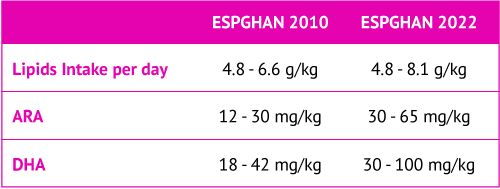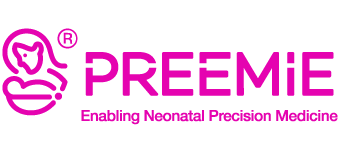ESPGHAN Guidelines: Neonatal Nutrition
 The European Society for Paediatric Gastroenterology, Hepatology and Nutrition (ESPGHAN) is a group dedicated to promoting the health of children with a focus on the gastrointestinal tract, liver, and nutritional needs. ESPGHAN disseminates science-based information and advice on the best practices to meet the nutritional needs of children. ESPGHAN has four special interest groups dedicated to specific aspects of pediatric health: gut microbiota and modification, clinical malnutrition, neonatal nutrition, and childhood obesity. The neonatal nutrition committee of ESPGHAN provides neonatal professionals with quick and easy access to recommendations on nutrient intakes and nutritional practice in preterm infants with birth weight less than 1800 g.
The European Society for Paediatric Gastroenterology, Hepatology and Nutrition (ESPGHAN) is a group dedicated to promoting the health of children with a focus on the gastrointestinal tract, liver, and nutritional needs. ESPGHAN disseminates science-based information and advice on the best practices to meet the nutritional needs of children. ESPGHAN has four special interest groups dedicated to specific aspects of pediatric health: gut microbiota and modification, clinical malnutrition, neonatal nutrition, and childhood obesity. The neonatal nutrition committee of ESPGHAN provides neonatal professionals with quick and easy access to recommendations on nutrient intakes and nutritional practice in preterm infants with birth weight less than 1800 g.
Preterm infants have increased nutritional requirements compared to full-term infants, and recommendations have been made by ESPGHAN regarding the optimal ranges for their nutrient intakes. However, breast milk alone does not meet these recommendations. Therefore, breast milk often requires the addition of a breast milk fortifier, which is a commercial product designed to enhance the energy, protein, fat, mineral, and micronutrient content of breast milk.
In this blog we focus on the latest ESPGHAN recommendation for protein, fat, fatty acids, and energy intake, and on the use of mother’s or donor milk in preterm infant feeding. We will compare their recommendations from 2010 with the revised recommendations from 2022.
Protein Intake Recommendations
Protein quality and quantity are crucial, due to their important role in the growth and development of infants. As explained above breast milk alone does not provide the higher protein requirements to match intrauterine growth rates. Studies have shown improved preterm infant growth rates with increased protein intake. ESPGHAN recommendations for protein to match intrauterine growth rates are as follows:

The recommendation of 2022 also states that protein intake can be increased to 4.5 g/kg per day if growth is slow but provided protein quality is good, and there are no other causes for the slow growth. ESPGHAN 2022 also recommends regular monitoring of plasma urea concentrations to help estimate the actual protein that the infant intakes and absorption. Their recommendation is that for low urea concentrations the doctor needs to increase protein intake up to 4.5 grams per kilogram per day, but for high concentrations the infant is likely getting enough protein. However, if the urea concentrations exceed 34 mg/dL without the infant having any renal issues, and there is sufficient energy intake, then ESPGHAN 2022 recommends reducing the protein intake.
Fat and Fatty Acid Intake Recommendations
Preterm babies need a lot of energy, and about half of this energy comes from the fats they get from the breast milk that they ingest. Fat also provides complex things like fatty acids, vitamins, and other complex fats. Breast milk contains about 3.2 to 4.0 grams of fat per 100 milliliters. This fat is composed of tiny globules made up of 98-99% triglycerides and a membrane enclosing them that has other important things like phospholipids, cholesterol, and other highly bioactive components. Fatty acids are the building blocks of the fat in our bodies. Certain fatty acids such as arachidonic acid (ARA) and docosahexaenoic acid (DHA) are actively transferred through the placenta during the third trimester of pregnancy and they are essential for neurological development. Some preterm infants may not have been exposed to this placental transfer since they were born too soon, and so might not have enough ARA or/and DHA. Furthermore, their bodies can’t make them out of other fats as they should. Not having enough of these fats can lead to problems such as increased risk of retinopathy of prematurity (a common eye disease in preterm infants), septicemia (also called sepsis, blood poisoning by bacteria), and severe bronchopulmonary dysplasia (a form of chronic lung disease that affects infants).
One way to make sure that preterm babies get enough ARA or/and DHA in their daily diet is to add these polyunsaturated fatty acids to their food; keep in mind that we should not exceed the daily recommended dose. Below are the ESPGHAN 2022 revised recommendations for fat, ARA, and DHA. As you can see the 2022 recommendations support a much larger dosage of both ARA and DHA. These recommendations are supported by a study by Hellstorm and colleagues (2021) undertaken at Lund University in Sweden.

Energy Intake Recommendations
Energy is crucial for preterm infants. Premature neonates can have an energy-deficient state due to illness, neurodevelopmental energy requirements, drops in blood oxygen levels, and the possibility of stressful stimuli. Failure to correct energy deficiency in premature infants may lead to adverse effects such as neurodevelopmental delay and negative long-term metabolic and cardiovascular outcomes. The old and new recommendations by ESPGHAN are as follows:

ESPGHAN 2022 recommends that the total energy intake for a healthy preterm infant should be between 115 to 140 kcal/kg per day, and that energy intakes exceeding 140 kcal/kg per day are recommended only if growth falls below the recommended range.
Regarding breast milk, ESPGHAN states that the first choice for feeding infants is to use mother’s own milk (MOM) over donor human milk (DHM). However, if MOM is insufficient, then the infant should receive fortified DHM over preterm formula, especially for those infants born at less than 32 weeks’ gestation or birth weight less than 1500 g. Furthermore, pasteurization of MOM is not recommended as it reduces the activity of bioactive factors.
In conclusion, nutritional needs of preterm infants are unique and ever changing. The variability in the nutrient content of mother’s or donor milk emphasizes the importance of a tailored approach in order to meet ESPGHAN recommendations for all macronutrients. Fortunately, the Preemie ecosystem tackles this challenge head-on by facilitating rapid and cost-effective analysis of human milk composition, and providing data-driven calculations for personalized fortification. The use of the Preemie ecosystem ensures that every preterm infant receives optimal nutritional support by ensuring human milk meets the new ESPGHAN recommendations.
REFERENCES
Embleton, N. D., Jennifer Moltu, S., Lapillonne, A., van den Akker, C. H. P., Carnielli, V., Fusch, C., Gerasimidis, K., van Goudoever, J. B., Haiden, N., Iacobelli, S., Johnson, M. J., Meyer, S., Mihatsch, W., de Pipaon, M. S., Rigo, J., Zachariassen, G., Bronsky, J., Indrio, F., Köglmeier, J., de Koning, B., … Domellöf, M. (2023). Enteral Nutrition in Preterm Infants (2022): A Position Paper From the ESPGHAN Committee on Nutrition and Invited Experts. Journal of pediatric gastroenterology and nutrition, 76(2), 248–268. https://doi.org/10.1097/MPG.0000000000003642
Hellström, A., Pivodic, A., Gränse, L., Lundgren, P., Sjöbom, U., Nilsson, A. K., Söderling, H., Hård, A. L., Smith, L. E. H., & Löfqvist, C. A. (2021). Association of Docosahexaenoic Acid and Arachidonic Acid Serum Levels With Retinopathy of Prematurity in Preterm Infants. JAMA network open, 4(10), e2128771. https://doi.org/10.1001/jamanetworkopen.2021.28771

